Realization of 4 × 200 Gbps 4-QAM OFDM-OWC System Using Higher Order OAM Modes for HAP-to-Satellites Scenario
Abstract
1. Introduction
2. Literature Review
- To investigate the system performance over long-reach transmission at 200 Gbps for four operating modes viz. LG [0,0], LG [0,13], LG [0,40] and LG [0,80].
- To evaluate the system performance in terms of error vector magnitude (EVM), signal power, SNR, and OSNR.
- To validate the system performance with existing ones.
3. Proposed Design
4. Results and Analysis
5. Conclusions
Author Contributions
Funding
Institutional Review Board Statement
Informed Consent Statement
Data Availability Statement
Conflicts of Interest
References
- Kong, H.; Lin, M.; Zhu, W.P.; Amindavar, H.; Alouini, M.S. Multiuser Scheduling for Asymmetric FSO/RF Links in Satellite-UAV-Terrestrial Networks. IEEE Wirel. Commun. Lett. 2020, 9, 1235–1239. [Google Scholar] [CrossRef]
- Nguyen, T.V.; Le, H.D.; Dang, N.T.; Pham, A.T. On the Design of Rate Adaptation for Relay-Assisted Satellite Hybrid FSO/RF Systems. IEEE Photonics J. 2022, 14, 1–11. [Google Scholar] [CrossRef]
- Liu, X.; Lin, M.; Zhu, W.P.; Wang, J.Y.; Upadhyay, P.K. Outage Performance for Mixed FSO-RF Transmission in Satellite-Aerial- Terrestrial Networks. IEEE Photonics Technol. Lett. 2020, 32, 1349–1352. [Google Scholar] [CrossRef]
- Refaai, A.; Fathi, M.; Sree, A.; Newagy, F.; Aly, M.H.; Elhennawy, H. Cooperative Relay Orbital Satellite Optical Communication under Turbulent Channels: Performance Analysis. Opt. Laser Technol. 2023, 161, 109110. [Google Scholar] [CrossRef]
- Ju, C.; Liu, N.; Zhang, Z.; Chen, X. A Flexible Optical OFDMA-PON Upstream Scheme Based on Modulation Format Conversion Technique. Opt. Laser Technol. 2017, 90, 237–241. [Google Scholar] [CrossRef]
- Dong, Y.; Giddings, R.P.; Tang, J. Hybrid OFDM-Digital Filter Multiple Access PONs. J. Light. Technol. 2018, 36, 5640–5649. [Google Scholar] [CrossRef]
- Lee, D.; Sasaki, H.; Fukumoto, H.; Hiraga, K. Orbital Angular Momentum (OAM) Multiplexing: An Enabler of a New Era of Wireless Communications. IEICE Trans. Commun. 2017, 100, 1044–1063. [Google Scholar] [CrossRef]
- Dutta, B.; Sarkar, N.; Atta, R.; Kuiri, B.; Sekhar, A. 1600 Gbps PAM-4 FSO Link Enabled Using OFCL-Based WDM and OAM-Multiplexing Techniques. Results Opt. 2022, 9, 100287. [Google Scholar] [CrossRef]
- Liu, J.; Lin, Z.; Zhu, H.; Shen, L.; Mo, S.; Li, Z.; Zhang, J.; Zhang, J.; Lan, X.; Liu, J.; et al. 1120-Channel OAM-MDM-WDM Transmission over a 100-Km Single-Span Ring-Core Fiber Using Low-Complexity 4 × 4 MIMO Equalization. Opt. Express 2022, 30, 18199. [Google Scholar] [CrossRef]
- Li, S.; Wang, J. Adaptive Power-Controllable Orbital Angular Momentum (OAM) Multicasting. Sci. Rep. 2015, 5, 9677. [Google Scholar] [CrossRef]
- Rjeb, A.; Fathallah, H.; Khaled, I.; Machhout, M.; Alshebeili, S.A. A Novel Hyperbolic Tangent Profile for Optical Fiber for Next Generation OAM-MDM Systems. IEEE Access 2020, 8, 226737–226753. [Google Scholar] [CrossRef]
- Arum, S.C.; Grace, D.; Mitchell, P.D. Delivering Extended Cellular Coverage and Capacity Using High-Altitude Platforms. Electronics 2022, 11, 1508. [Google Scholar] [CrossRef]
- Erdogan, E.; Yahia, O.B.; Kurt, G.K.; Yanikomeroglu, H. Optical HAPS Eavesdropping in Vertical Heterogeneous Networks. IEEE Open J. Veh. Technol. 2023, 4, 208–216. [Google Scholar] [CrossRef]
- Wang, X.; Zhao, S.; Shi, L.; Li, Y.; Zhao, G.; Zhu, Z.; Zhao, W. Error Rate Performance Analysis of Optical Links between High Altitude Platforms with Misalignment Fading by Hoyt Distribution. Optik 2013, 124, 6516–6518. [Google Scholar] [CrossRef]
- Swaminathan, R.; Sharma, S.; Vishwakarma, N.; Madhukumar, A.S. HAPS-Based Relaying for Integrated Space–Air–Ground Networks with Hybrid FSO/RF Communication: A Performance Analysis. IEEE Trans. Aerosp. Electron. Syst. 2021, 57, 1581–1599. [Google Scholar]
- Sachdeva, S.; Kaur, S.; Arora, R.; Sindhwani, M.; Arora, K.; Cho, W.; Joshi, G.P.; Doo, I.C. Ultra-High Capacity Optical Satellite Communication System Using PDM-256-QAM and Optical Angular Momentum Beams. Sensors 2023, 23, 786. [Google Scholar] [CrossRef] [PubMed]
- Kumari, M.; Arya, V. Realization of High-Speed OWC Links by Incorporating Hybrid OCDMA and MDM Scheme for HAP-to-Satellite Applications. Opt. Quantum Electron. 2024, 56, 546. [Google Scholar] [CrossRef]
- Fontaine, N.K.; Ryf, R.; Chen, H.; Neilson, D.T.; Kim, K.; Carpenter, J. Laguerre-Gaussian Mode Sorter. Nat. Commun. 2019, 26, 1865. [Google Scholar] [CrossRef]
- Banawan, M.; Mishra, S.K.; Gouin, A.; Bacon, N.; Guan, X.; Wang, L. Using Standard 2 × 2 MIMO to Increase Capacity of Spatial Multiplexing with OAM Modes. J. Light. Technol. 2023, 41, 1974–1984. [Google Scholar] [CrossRef]
- Pesek, P.; Zvanovec, S.; Chvojka, P.; Ghassemlooy, Z.; Haigh, P.A. Demonstration of a Hybrid FSO/VLC Link for the Last Mile and Last Meter Networks. IEEE Photonics J. 2019, 11, 1–7. [Google Scholar] [CrossRef]
- Ghazi, A.; Aljunid, S.A.; Idrus, S.Z.S.; Fareed, A.; Al-Dawoodi, A.; Mohsin, A.H. Design of a Hybrid WDMA-Optical-CDMA over Multi-Mode Fiber Transmission System Based on LG Modes for Short Haul-Local Area Network. J. Phys. Conf. Ser. 2021, 1793. [Google Scholar] [CrossRef]
- Sarangal, H.; Nisar, K.S.; Thapar, S.S.; Singh, A.; Malhotra, J. Performance Evaluation of 120 GB/s Hybrid FSO-SACOCDMA-MDM System Using Newly Designed ITM-Zero Cross-Correlation Code. Opt. Quantum Electron. 2021, 53, 64. [Google Scholar] [CrossRef]
- Mostafa, S.; Mohamed, A.E.A. Performance Evaluation of SAC-OCDMA System in Free Space Optics and Optical Fiber System Based on Different Types of Codes. Wirel. Pers. Commun. 2017, 96, 2843–2861. [Google Scholar] [CrossRef]
- Ghazi, A.; Aljunid, S.A.; Noori, A.; Idrus, S.Z.S.; Rashidi, C.B.M.; Al-Dawoodi, A. Design & Investigation of 10 × 10 Gbit/s MDM over Hybrid FSO Link under Different Weather Conditions and Fiber to the Home. Bull. Electr. Eng. Inform. 2019, 8, 121–126. [Google Scholar] [CrossRef]
- Ghazi, A.; Aljunid, S.A.; Syed Idrus, S.Z.; Fareed, A.; Rashidi, C.B.M.; Al-Dawoodi, A. Comparison of Laguerre-Gaussian and Hermite-Gaussian Modes for Optical-CDMA over Multi-Mode Fiber. IOP Conf. Ser. Mater. Sci. Eng. 2020, 767. [Google Scholar] [CrossRef]
- Srivastava, V.; Mandloi, A.; Soni, G.G. Outage Probability and Average BER Estimation of FSO System Employing Wavelength Diversity. Opt. Quantum Electron. 2019, 51, 229. [Google Scholar] [CrossRef]
- Yeh, C.H.; Lin, W.P.; Luo, C.M.; Xie, Y.R.; Chang, Y.J.; Chow, C.W. Utilizing Single Lightwave for Delivering Baseband/Fso/Mmw Traffics Simultaneously in Pon Architecture. IEEE Access 2019, 7, 138927–138931. [Google Scholar] [CrossRef]
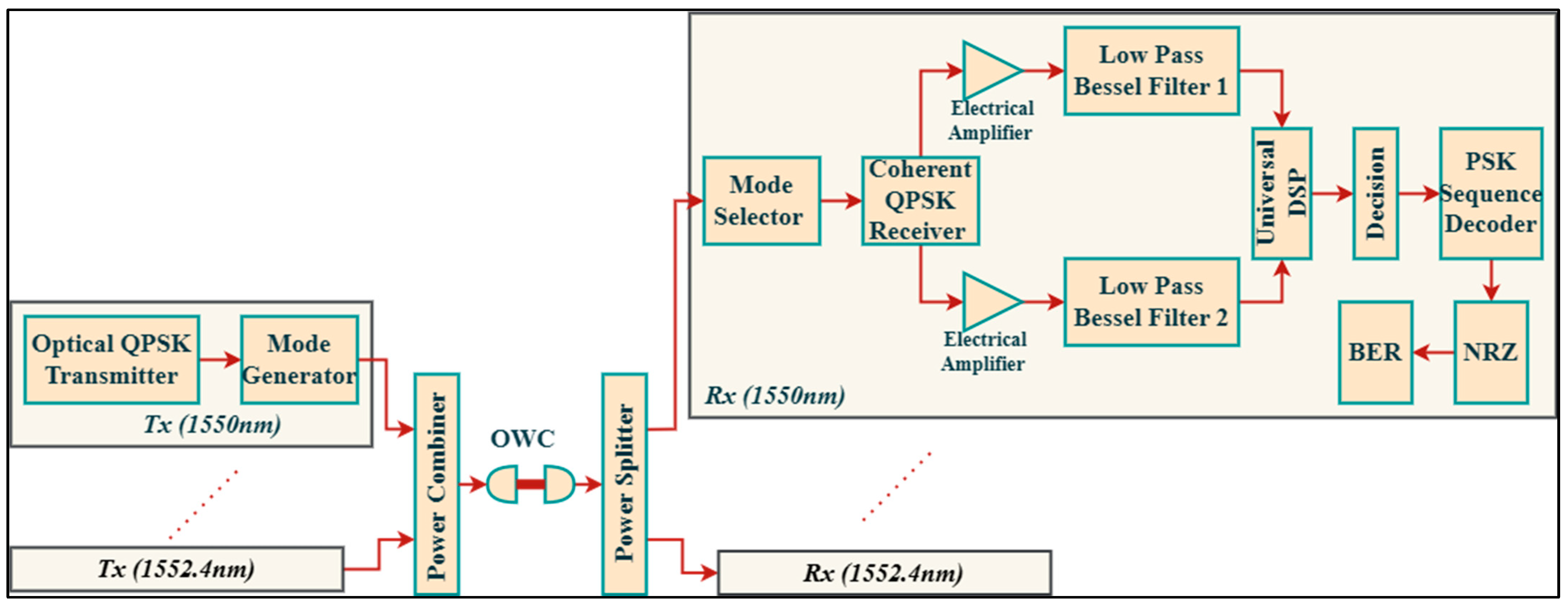

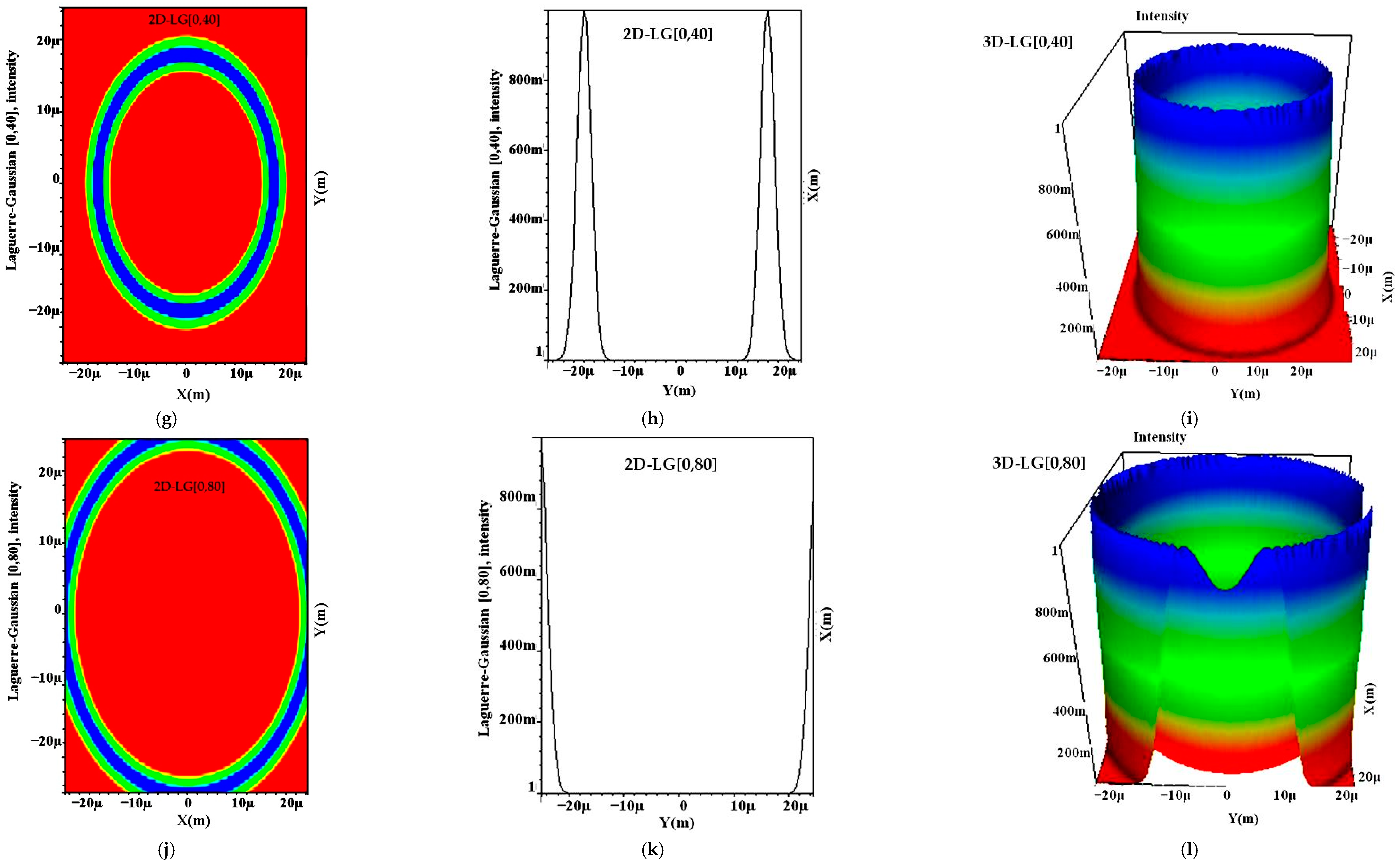


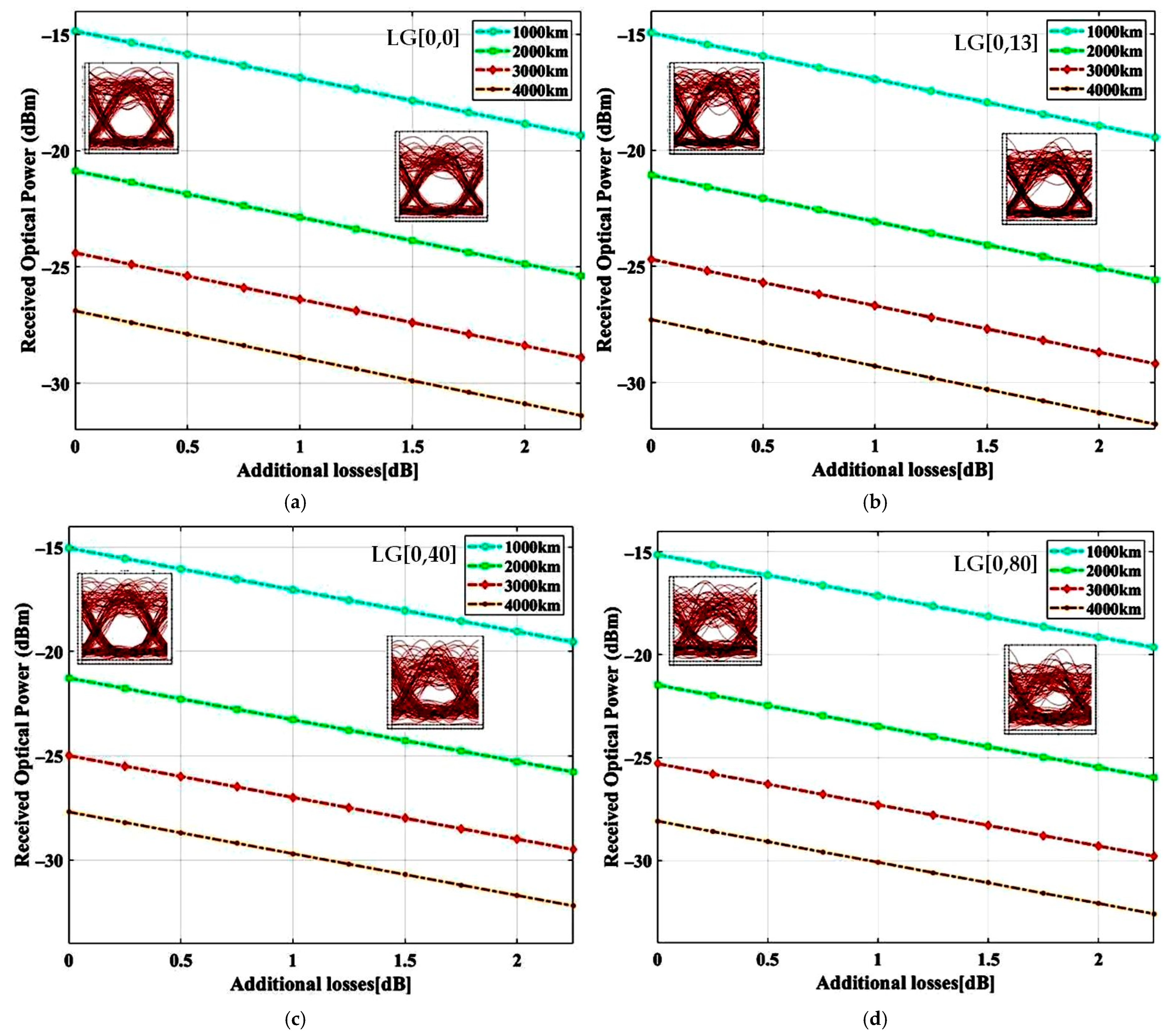
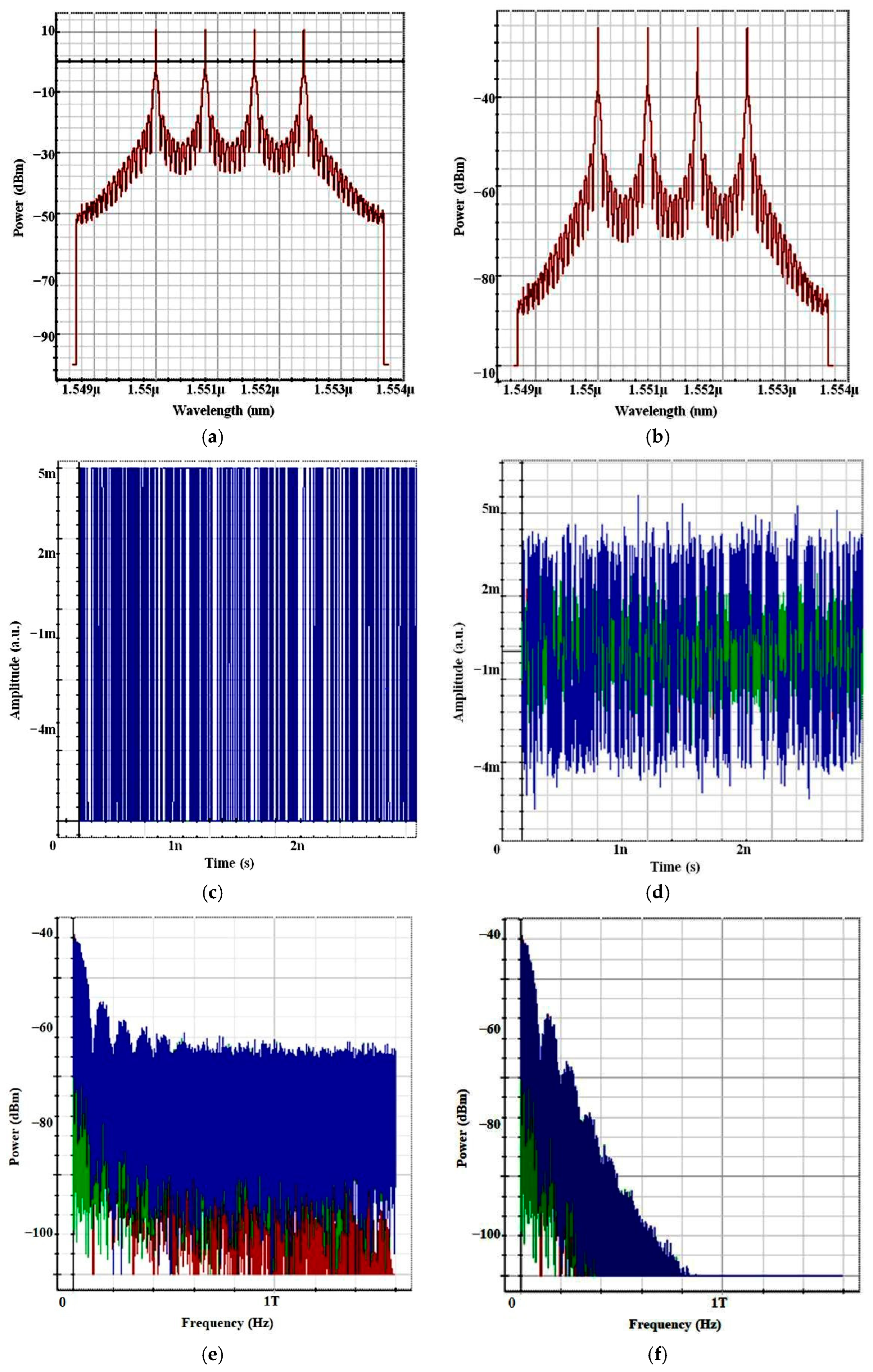
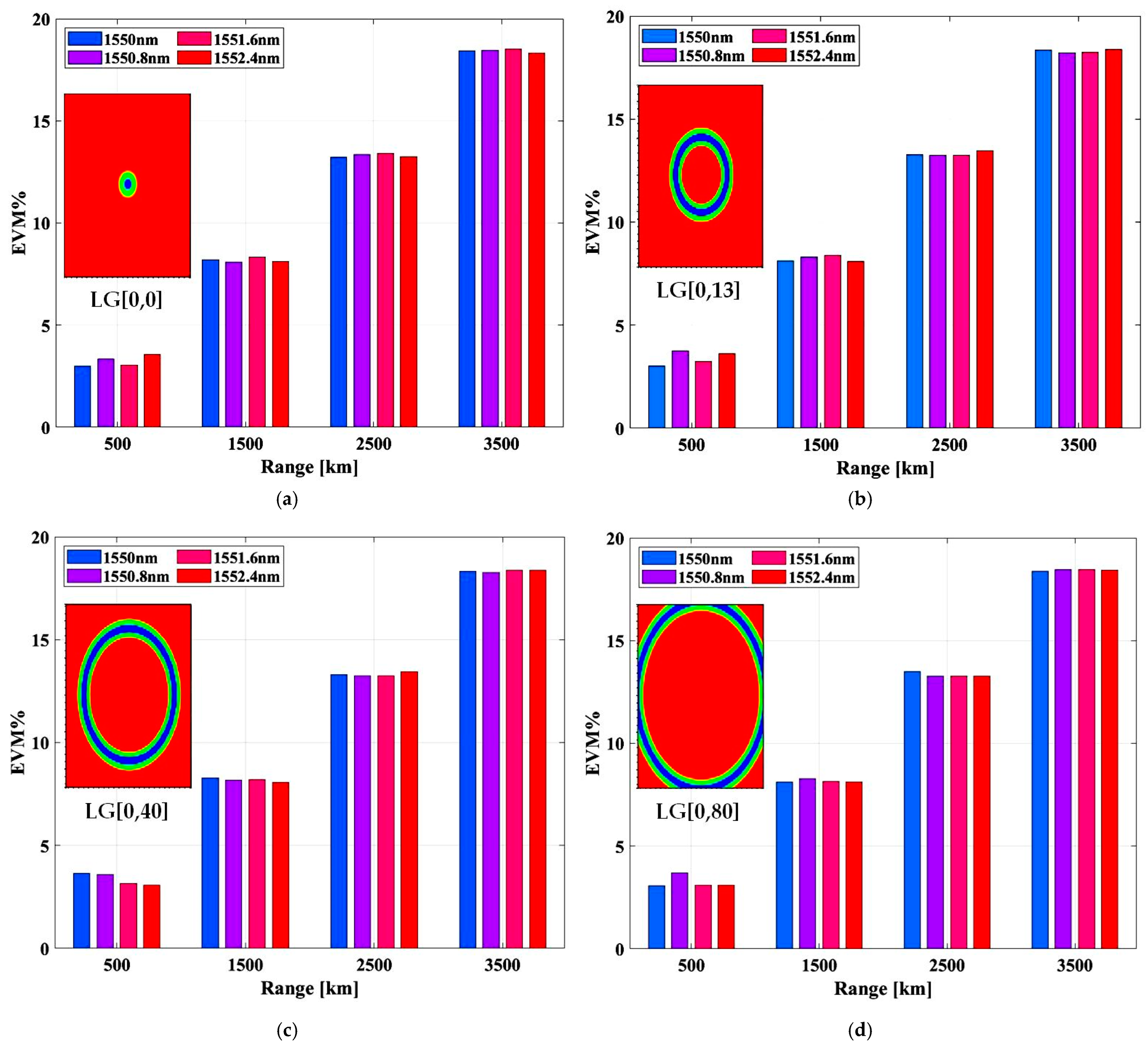
| Component | Parameters | Value | Unit |
|---|---|---|---|
| QPSK transmitter | Wavelength | 1550, 1550.8, 1551.6, 1552.4 | nm |
| Data rate | 200 | Gbps | |
| Power | 20 | dB | |
| Linewidth | 0.1 | MHz | |
| Azimuth | 45 | deg | |
| OWC channel | Reference wavelength | 1550 | nm |
| Range | 500–5000 | km | |
| Tx and Rx aperture diameter | 15 | cm | |
| Tx and Rx optics efficiency | 0.8 | ||
| Free space path loss | Yes | ||
| Geometric gain | Yes | ||
| Tx and Rx pointing error | 0–1 | µrad | |
| Additional losses | 0–2.5 | dB | |
| QPSK Receiver | Wavelength | 1550, 1550.8, 1551.6, 1552.4 | nm |
| Power | 10 | dB | |
| Responsivity | 1 | A/W | |
| Dark current | 8 | nA | |
| Electrical amplifier | Gain | 20 | dB |
| Low pass Bessel filter | Cut-off frequency | 0.75 × Bit rate | Hz |
| PSK sequence decoder | Bits per symbol | 2 |
| Wavelengths (nm) | LG [0,0] | LG [0,13] | LG [0,40] | LG [0,80] |
|---|---|---|---|---|
| 1550 | 5000 | 5000 | 5000 | 4000 |
| 1550.8 | 5000 | 5000 | 5000 | 3700 |
| 1551.6 | 5000 | 5000 | 4800 | 3500 |
| 1552.4 | 5000 | 5000 | 4700 | 3300 |
| Received Power (dBm) | ||||
|---|---|---|---|---|
| Range (km) | LG [0,0] | LG [0,13] | LG [0,40] | LG [0,80] |
| 1000 | −19.34 | −19.45 | −19.54 | −19.64 |
| 2000 | −25.37 | −25.57 | −25.77 | −25.97 |
| 3000 | −28.37 | −29.19 | −29.49 | −29.79 |
| 4000 | −31.39 | −31.79 | −32.19 | −32.59 |
| Tx Pointing Error (µrad) | Gain (dB) | Input Signal (dBm) | Output Signal (dBm) | SNR (dB) | OSNR (dB) |
|---|---|---|---|---|---|
| 0.1 | −40.80 | 26.53 | −14.26 | 55.21 | 67.25 |
| 0.3 | −40.83 | 26.54 | −14.28 | 54.83 | 66.87 |
| 0.5 | −40.89 | 26.54 | −14.35 | 54.60 | 66.64 |
| 0.7 | −40.99 | 26.54 | −14.45 | 54.79 | 66.83 |
| 0.9 | −41.12 | 26.54 | −14.58 | 54.59 | 66.63 |
| Range (km) | LG [0,0] | LG [0,13] | LG [0,40] | LG [0,80] |
|---|---|---|---|---|
| 1000 | 5.53 | 5.51 | 5.52 | 5.60 |
| 2000 | 10.68 | 10.76 | 10.77 | 10.89 |
| 3000 | 15.80 | 15.84 | 15.84 | 15.80 |
| 4000 | 20.86 | 20.80 | 20.78 | 20.81 |
| 5000 | 25.94 | 25.86 | 25.68 | 25.75 |
| Ref | No. of Modes | Mode | Data Rate (Gbps) | Wireless Range (km) | Turbulent Condition | No. of Channels | SNR (dB) | BER | Complexity and Cost | Applications |
|---|---|---|---|---|---|---|---|---|---|---|
| [20] | Not used | Not used | 0.0126 | 500 | Weak, moderate, strong | 2 | Not defined | 10−3 | Moderate | Internet of things |
| [21] | 4 | 01, 02, 03, 04 | 2.488 | Not used | Not used | 4 | Not defined | 10−9 | High | Short distance-local area network |
| [22] | 2 | 00, 01 | 20 | 1750 | Not defined | 6 | Not defined | 10−9 | High | Secure wireless network |
| [23] | Not used | Not used | 0.622 | 500 | Moderate | 3 | 22 | 10−9 | Moderate | Tri-play services |
| [24] | 9 | 00, 01, 02, 10, 11, 12, 20, 22, 21 | 10 | 3200 | Not defined | 10 | Not defined | 10−9 | Moderate | Fiber to the home |
| [25] | 3 | 01, 02, 03 | 1.866 | Not used | Not used | 3 | Not defined | 10−9 | High | Hybrid wired-wireless networks |
| [26] | Not used | Not used | Not defined | 1.5 k | Weak-strong | Not defined | 36 | 10−3 | Moderate | Secure wireless network |
| [27] | Not used | Not used | 10 | 160 | Not used | Not defined | Not defined | 10−9 | High | Hybrid wired-wireless networks |
| This work | 4 | 0,0; 0,13; 0,40; 0,80 | 200 | 5000 | Moderate | 4 | 55 | 10−3 | Medium | High speed and high capacity satellite-to-ground communication |
Disclaimer/Publisher’s Note: The statements, opinions and data contained in all publications are solely those of the individual author(s) and contributor(s) and not of MDPI and/or the editor(s). MDPI and/or the editor(s) disclaim responsibility for any injury to people or property resulting from any ideas, methods, instructions or products referred to in the content. |
© 2024 by the authors. Licensee MDPI, Basel, Switzerland. This article is an open access article distributed under the terms and conditions of the Creative Commons Attribution (CC BY) license (https://creativecommons.org/licenses/by/4.0/).
Share and Cite
Kumari, M.; Mishra, S.K. Realization of 4 × 200 Gbps 4-QAM OFDM-OWC System Using Higher Order OAM Modes for HAP-to-Satellites Scenario. Photonics 2024, 11, 294. https://doi.org/10.3390/photonics11040294
Kumari M, Mishra SK. Realization of 4 × 200 Gbps 4-QAM OFDM-OWC System Using Higher Order OAM Modes for HAP-to-Satellites Scenario. Photonics. 2024; 11(4):294. https://doi.org/10.3390/photonics11040294
Chicago/Turabian StyleKumari, Meet, and Satyendra K. Mishra. 2024. "Realization of 4 × 200 Gbps 4-QAM OFDM-OWC System Using Higher Order OAM Modes for HAP-to-Satellites Scenario" Photonics 11, no. 4: 294. https://doi.org/10.3390/photonics11040294
APA StyleKumari, M., & Mishra, S. K. (2024). Realization of 4 × 200 Gbps 4-QAM OFDM-OWC System Using Higher Order OAM Modes for HAP-to-Satellites Scenario. Photonics, 11(4), 294. https://doi.org/10.3390/photonics11040294






